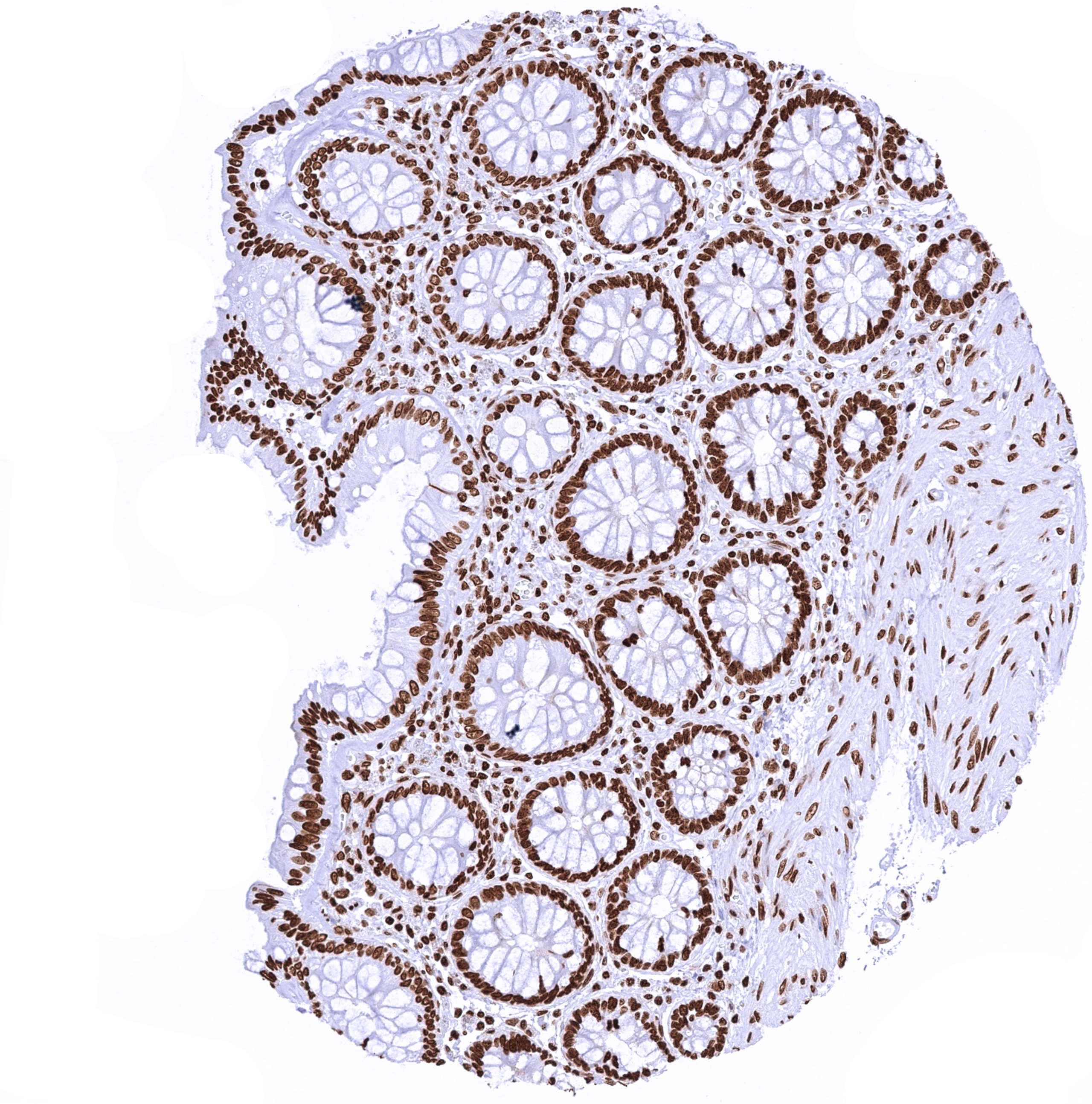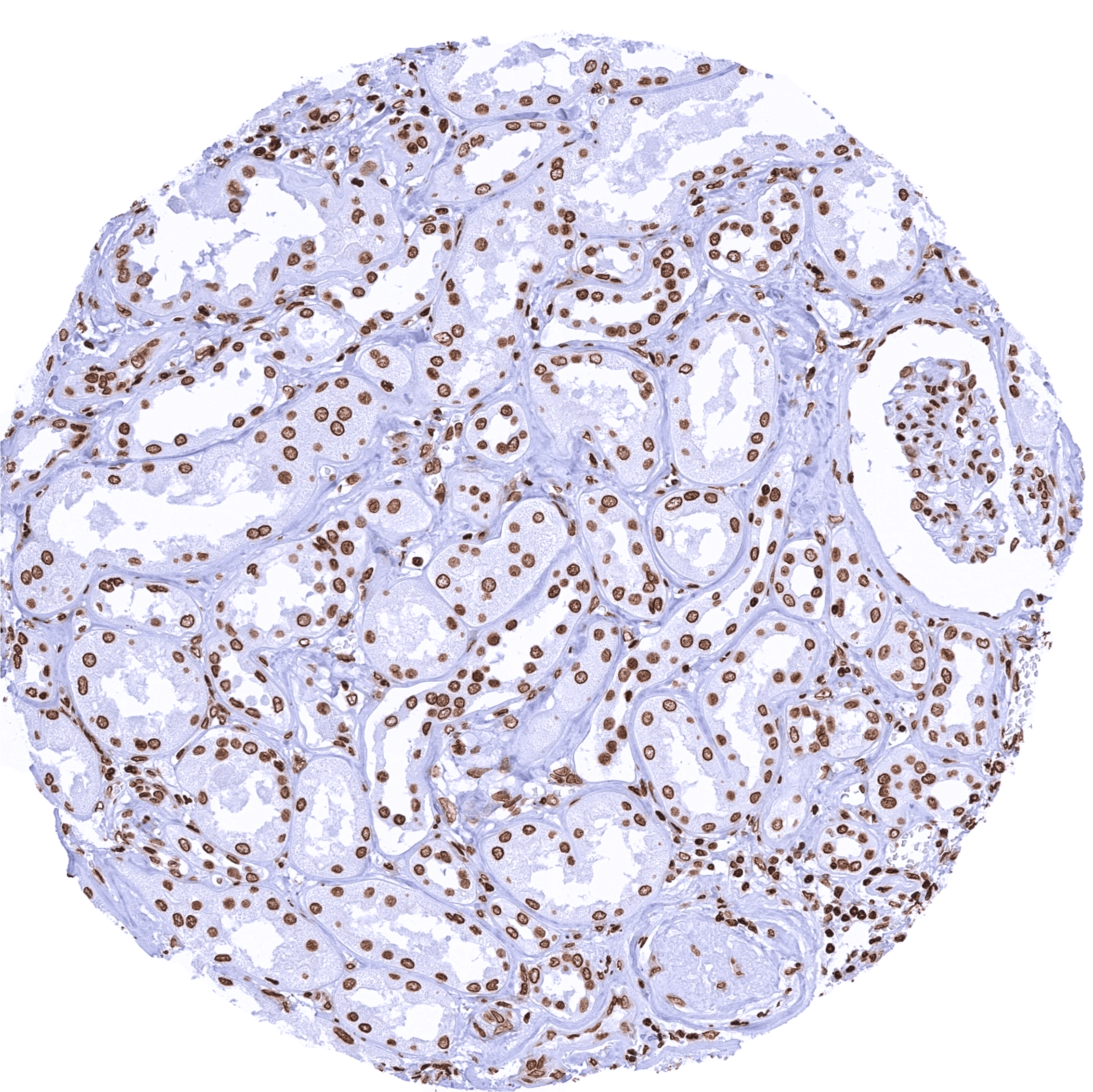295,00 € – 995,00 €
Product details
Synonyms = H3.3 Histone A, H3.3A, H3F3A, H3F3, H3 Histone Family Member 3A, H3 Histone, Family 3A, Histone H3.3, BRYLIB1, H3- 3B, H3.3B, H3F3B
Antibody type = Mouse monoclonal / IgG
Clone = MSVA-903M
Positive control = Lymph node: A strong nuclear Histone H3 staining should be seen in all cells while strongest staining intensity occurs in cells of germinal centres.
Negative control = Colon, Kidney: Histone H3 staining should be seen in nuclei only. Cytoplasmic staining should not be seen.
Cellular localization = Intracelullar
Reactivity = Human
Application = Immunohistochemistry
Dilution = 1:100 – 1:200
Intended Use = Research Use Only
Relevance of Antibody
Histone H3 is Ubiquitously expressed nuclear protein.
Biology Behind
Histone H3 is one of the five main histones in human cells. Histones are small basic proteins which represent the main protein components of the chromatin. They package and organize DNA at the level of the nucleosomes which constitute the functional units of the chromatin. The dynamics of this organization permits the compaction of the genome, while enabling all cellular processes operating on DNA, such as transcription, replication, recombination and repair. Human cells contain 7 known sequence variants of histone H3. These are denoted as Histone H3.1, Histone H3.2, Histone H3.3, Histone H3.4 (H3T), Histone H3.5, Histone H3.X and Histone H3.Y but have highly conserved sequences differing only by a few amino acids. The N-terminus of H3 protrudes from the globular nucleosome core and is subject to post-translational modifications that can influence cellular functions.
Staining Pattern in Normal Tissues
Images describing the Histone H3 staining pattern in normal tissues obtained by the antibody MSVA-903M are shown in our “Normal Tissue Gallery”.
| Brain | Cerebrum | Histone H3 staining of all nuclei. |
| Cerebellum | Histone H3 staining of all nuclei. | |
| Endocrine Tissues | Thyroid | Histone H3 staining of all nuclei. |
| Parathyroid | Histone H3 staining of all nuclei. | |
| Adrenal gland | Histone H3 staining of all nuclei. | |
| Pituitary gland | Histone H3 staining of all nuclei. | |
| Respiratory system | Respiratory epithelium | Histone H3 staining of all nuclei. |
| Lung | Histone H3 staining of all nuclei. | |
| Gastrointestinal Tract | Salivary glands | Histone H3 staining of all nuclei. |
| Esophagus | Histone H3 staining of all nuclei. In the squamous epithelium, the staining intensity decreases towards the surface. | |
| Stomach | Histone H3 staining of all nuclei. | |
| Duodenum | Histone H3 staining of all nuclei. | |
| Small intestine | Histone H3 staining of all nuclei. | |
| Appendix | Histone H3 staining of all nuclei. | |
| Colon | Histone H3 staining of all nuclei. | |
| Rectum | Histone H3 staining of all nuclei. | |
| Liver | Histone H3 staining of all nuclei. | |
| Gallbladder | Histone H3 staining of all nuclei. | |
| Pancreas | Histone H3 staining of all nuclei. | |
| Genitourinary | Kidney | Histone H3 staining of all nuclei. |
| Urothelium | Histone H3 staining of all nuclei. In the urothelium, the staining intensity decreases towards the surface. | |
| Male genital | Prostate | Histone H3 staining of all nuclei. |
| Seminal vesicles | Histone H3 staining of all nuclei. | |
| Testis | Histone H3 staining of all nuclei. | |
| Epididymis | Histone H3 staining of all nuclei. | |
| Female genital | Breast | Histone H3 staining of all nuclei. |
| Uterus, myometrium | Histone H3 staining of all nuclei. | |
| Uterus, ectocervix | Histone H3 staining of all nuclei. In the squamous epithelium, the staining intensity decreases towards the surface. | |
| Uterus endocervix | Histone H3 staining of all nuclei. | |
| Uterus, endometrium | Histone H3 staining of all nuclei. | |
| Fallopian Tube | Histone H3 staining of all nuclei. | |
| Ovary | Histone H3 staining of all nuclei. | |
| Placenta early | Histone H3 staining of all nuclei. | |
| Placenta mature | Histone H3 staining of all nuclei. | |
| Amnion | Histone H3 staining of all nuclei. | |
| Chorion | Histone H3 staining of all nuclei. | |
| Skin | Epidermis | Histone H3 staining of all nuclei. In the squamous epithelium, the staining intensity decreases towards the surface. |
| Sebaceous glands | Histone H3 staining of all nuclei. | |
| Muscle/connective tissue | Heart muscle | Histone H3 staining of all nuclei. |
| Skeletal muscle | Histone H3 staining of all nuclei. | |
| Smooth muscle | Histone H3 staining of all nuclei. | |
| Vessel walls | Histone H3 staining of all nuclei. | |
| Fat | Histone H3 staining of all nuclei. | |
| Stroma | Histone H3 staining of all nuclei. | |
| Endothelium | Histone H3 staining of all nuclei. | |
| Bone marrow/lymphoid tissue | Bone marrow | Histone H3 staining of all nuclei. |
| Lymph node | Histone H3 staining of all nuclei. | |
| Spleen | Histone H3 staining of all nuclei. | |
| Thymus | Histone H3 staining of all nuclei. | |
| Tonsil | Histone H3 staining of all nuclei. | |
| Remarks | Histone H3 staining of all nuclei. Variations of intensity are only slight. Highly proliferative cells tend to have higher histone H3 staining intensity. |
These findings are largely consistent with the RNA data described in the Human Protein Atlas (Tissue expression Histone H3).
Positive control = Lymph node: A strong nuclear Histone H3 staining should be seen in all cells while strongest staining intensity occurs in cells of germinal centres.
Negative control = Colon, Kidney: Histone H3 staining should be seen in nuclei only. Cytoplasmic staining should not be seen.
Staining Pattern in Relevant Tumor Types
Histone H3 is expressed in all tumor entities. For some cancer entities, a prognostic role has been proposed for the Histone H3 expression levels.
The TCGA findings on Histone H3 RNA expression in different tumor categories have been summarized in the Human Protein Atlas.
Compatibility of Antibodies
No data available at the moment
Protocol Recommendations
IHC users have different preferences on how the stains should look like. Some prefer high staining intensity of the target stain and even accept some background. Others favor absolute specificity and lighter target stains. Factors that invariably lead to more intense staining include higher concentration of the antibody and visualization tools, longer incubation time, higher temperature during incubation, higher temperature and longer duration of the heat induced epitope retrieval (slide pretreatment). The impact of the pH during slide pretreatment has variable effects and depends on the antibody and the target protein.
All images and data shown here and in our image galleries are obtained by the manual protocol described below. Other protocols resulting in equivalent staining are described as well.
Manual protocol
Freshly cut sections should be used (less than 10 days between cutting and staining). Heat-induced antigen retrieval for 5 minutes in an autoclave at 121°C in pH 7,8 Target Retrieval Solution buffer. Apply MSVA-903M at a dilution of 1:150 at 37°C for 60 minutes. Visualization of bound antibody by the EnVision Kit (Dako, Agilent) according to the manufacturer’s directions.
Potential Research Applications
- The prognostic relevance of Histone H3 expression in tumors needs to be investigated.
- Potential utility of Histone H3 as a nuclear marker in multicolor IHC studies.
Evidence for Antibody Specificity in IHC
There are two ways how the specificity of antibodies can be documented for immunohistochemistry on formalin fixed tissues. These are: 1. Comparison with a second independent method for target expression measurement across a large number of different tissue types (orthogonal strategy), and 2. Comparison with one or several independent antibodies for the same target and showing that all positive staining results are also seen with other antibodies for the same target (independent antibody strategy).
Orthogonal validation: For proteins such as Histone H3 which are expressed in virtually all tissues but restricted to specific cell types and cell compartments, orthogonal validation is not suited. However, the comparison of MSVA-903M immunostaining data with RNA expression data from three independent RNA screening studies, including the Human Protein Atlas (HPA) RNA-seq tissue dataset, the FANTOM5 project, and the Genotype-Tissue Expression (GTEx) project, which are all summarized in the Human Protein Atlas (Tissue expression Histone H3) provided concordant data.
Comparison of antibodies: A specific staining of the Histone H3 antibody MSVA-903M is supported by the identical staining pattern obtained by employing an independent commercially available Histone H3 antibody (termed “validation antibody”). This comparison also resulted in an identical distribution of tissues with rather low (liver, kidney) and rather high (lymphocytes, thymocytes, bone marrow cells) Histone H3 staining.


























